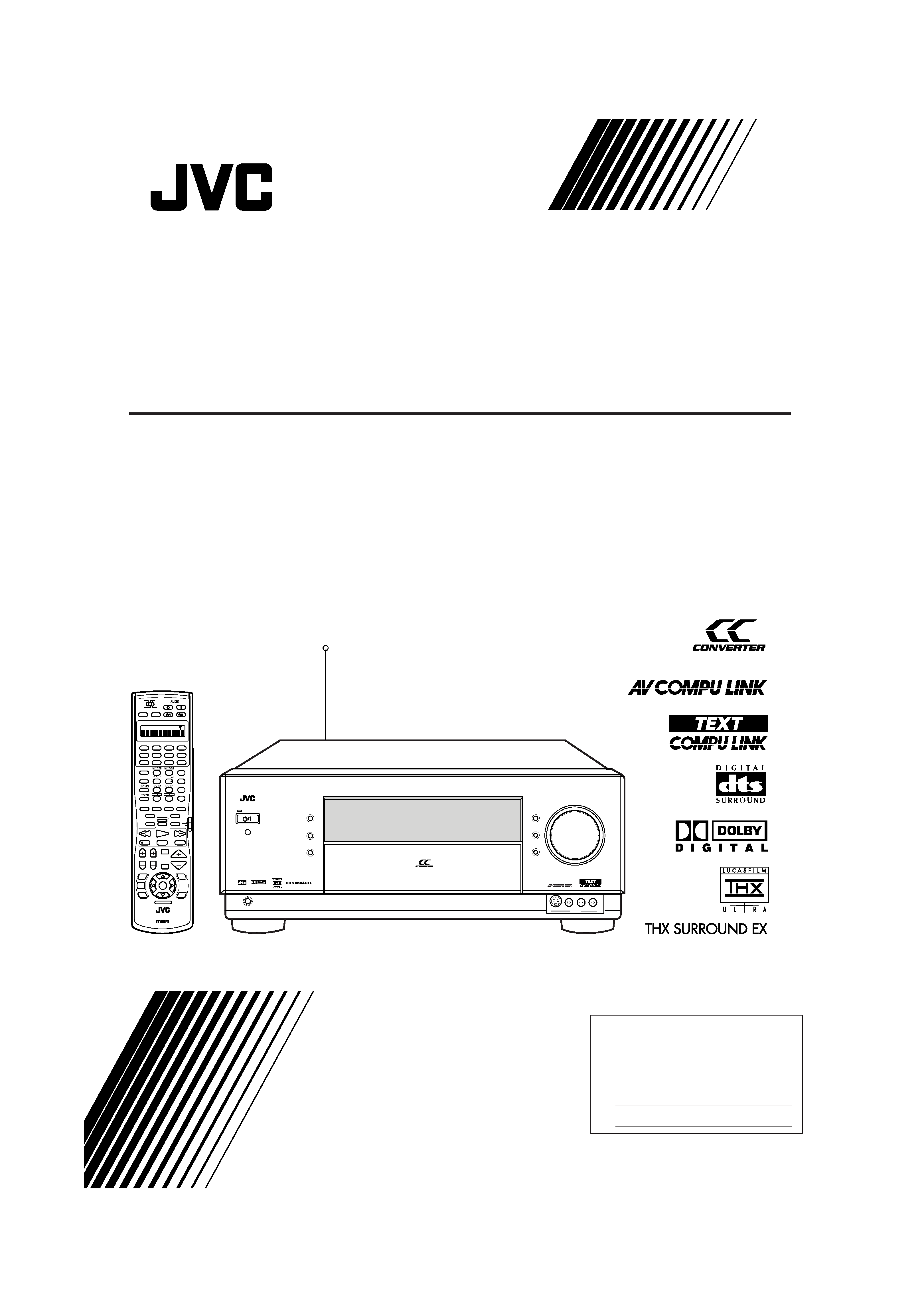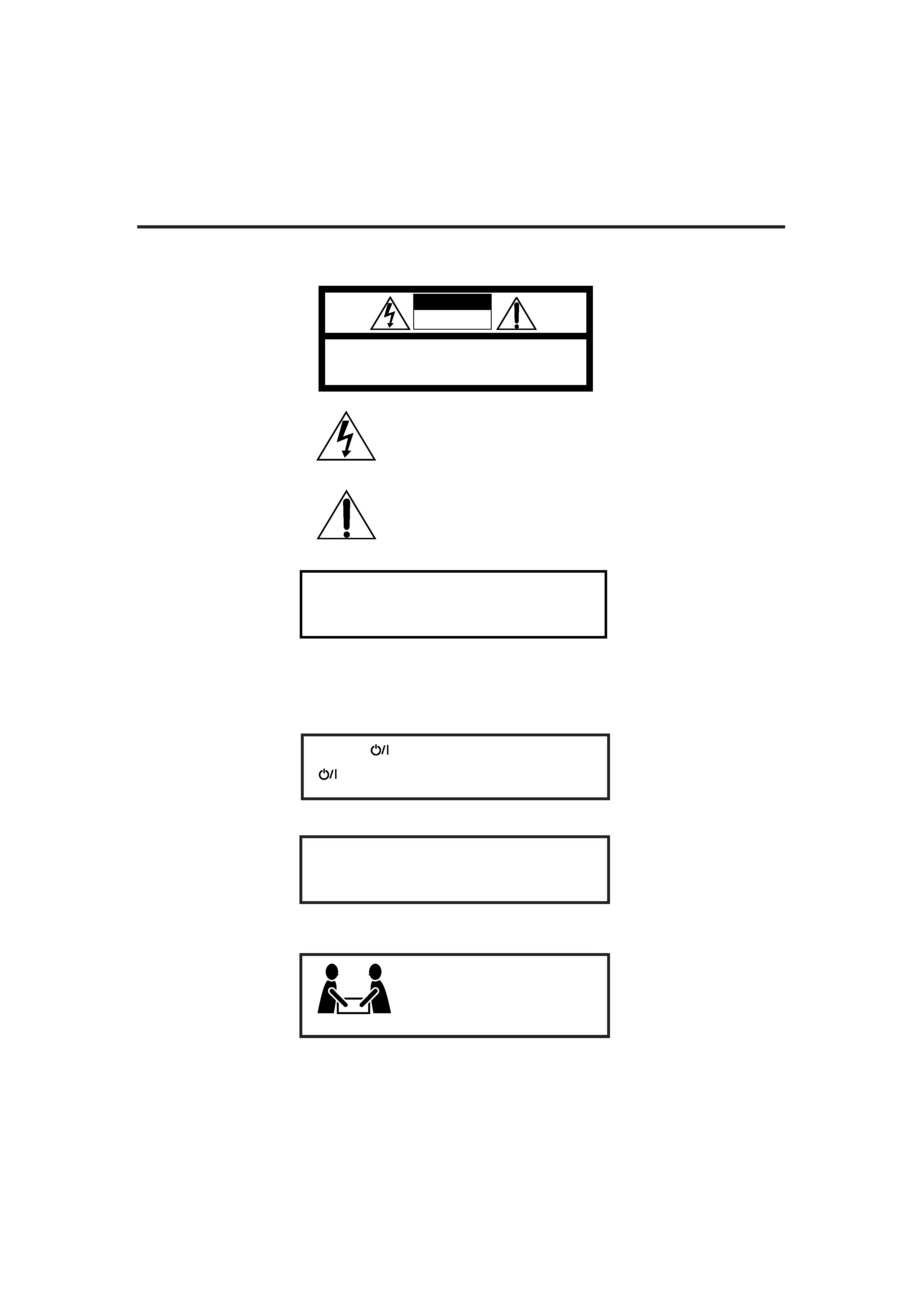
For Customer Use:
Enter below the Model No. and Serial
No. which are located either on the rear,
bottom or side of the cabinet. Retain this
information for future reference.
Model No.
Serial No.
LVT0722-003A
[J]
RX-DP10VBK
INSTRUCTIONS
AUDIO/VIDEO CONTROL RECEIVER
STANDBY / ON
STANDBY
PHONES
AUDIO/VIDEO CONTROL RECEIVER
DIMMER
CC CONVERTER
MAIN ROOM
ON/OFF
SUB ROOM
ON/OFF
DOOR
UP
DOOR
DOWN
MASTER VOLUME
RX-DP10V
DIGITAL
DIGITAL
SURROUND
S-VIDEO
VIDEO
L--AUDIO--R
VIDEO
CHANNEL
TV/VIDEO
MUTING
DVD
ON/OFF
ON/OFF
STANDBY/ON
STANDBY/ON
STANDBY
TV/CATV/DBS
VCR 1
ON
DVD MULTI
CD
CDR
PHONO
TAPE/MD
AM
ANALOG/DIGITAL
EFFECT
ROOM SIZE
SOUND
TEST
LINE DIRECT
CC CONVERTER
SLEEP
DIMMER
FM MODE
DSP
THX
SURROUND
RETURN
100+
ON/OFF
ON/OFF
MODE
WALL
INPUT
LIVENESS
SET
SETUP
MENU
ADJUST
MENU
DVD
MENU
EXIT
TEXT
DISPLAY
123
456
7/P
89
10
+
10
0
TV VOL
VOLUME
TUNING
STOP
PAUSE
LIGHT
FF/
/ REW
REC
PLAY
DOWN
UP
RM-SRXDP10J
REMOTE CONTROL
A/V CONTROL RECEIVER
VCR 1
VCR 2
FM
VIDEO
TV/DBS
SUB ROOM
TRANSMIT
LEARN
MAIN ROOM
SUB ROOM
MAIN ROOM
SUB ROOM LEARN
MAIN ROOM
TV
CATV/
DBS
RX-DP10VBK[J]cover_f
01.6.18, 7:02 PM
1

G-1
CAUTION:
TO REDUCE THE RISK OF ELECTRIC SHOCK.
DO NOT REMOVE COVER (OR BACK)
NO USER SERVICEABLE PARTS INSIDE.
REFER SERVICING TO QUALIFIED SERVICE PERSONNEL.
RISK OF ELECTRIC SHOCK
DO NOT OPEN
The lightning flash with arrowhead symbol,
within an equilateral triangle is intended to
alert the user to the presence of uninsulated
"dangerous voltage" within the product's
enclosure
that
may
be
of
sufficient
magnitude to constitute a risk of electric
shock to persons.
The exclamation point within an equilateral
triangle is intended to alert the user to the
presence
of
important
operating
and
maintenance (servicing) instructions in the
literature accompanying the appliance.
CAUTION
Warnings, Cautions and Others
CAUTION
To reduce the risk of electrical shocks, fire, etc.:
1.
Do not remove screws, covers or cabinet.
2.
Do not expose this appliance to rain or moisture.
WARNING: TO REDUCE THE RISK OF FIRE
OR ELECTRIC SHOCK, DO NOT EXPOSE
THIS APPLIANCE TO RAIN OR MOISTURE.
Caution
(STANDBY/ON) switch!
Disconnect the mains plug to shut the power off completely. The
(STANDBY/ON) switch in any position does not discon-
nect the mains line. The power can be remote controlled.
CautionSPEAKER LOAD SELECTOR switch!
Match the position of SPEAKER LOAD SELECTOR switch on the
back panel to the impedance of the speaker connected, to protect
from overheating.
CAUTION!
To avoid personal injury or accidentally
dropping the unit, have two persons unpack,
carry, and install the unit.
22.0 kg / 49.0 lb.
RX-DP10VBK[J]safety_f
01.6.18, 7:02 PM
1

G-2
Note to CATV system installer:
This reminder is provided to call the CATV system installer's
attention to Section 820-40 of the NEC which provides guidelines
for proper grounding and, in particular, specifies that the cable
ground shall be connected to the grounding system of the
building, as close to the point of cable entry as practical.
For the main unit:
This equipment has been tested and found to comply with the limits
for a Class B digital device, pursuant to part 15 of the FCC Rules.
These limits are designed to provide reasonable protection against
harmful interference in a residential installation.
This equipment generates, uses and can radiate radio frequency
energy and, if not installed and used in accordance with the
instructions,
may
cause
harmful
interference
to
radio
communications. However, there is no guarantee that interference
will not occur in a particular installation. If this equipment does cause
harmful interference to radio or television reception, which can be
determined by turning the equipment off and on, the user is
encouraged to try to correct the interference by one or more of the
following measures:
Reorient or relocate the receiving antenna.
Increase the separation between the equipment and receiver.
Connect the equipment into an outlet on a circuit different from that
to which the receiver is connected.
Consult the dealer or an experienced radio/TV technician for help.
Changes
or
modifications
not
expressly
approved
by
the
manufacturer for compliance could void the user's authority to
operate the equipment.
For the remote control:
This device complies with Part 15 of the FCC Rules. Operation is
subject to the following two conditions: (1) This device may not
cause harmful interference, and (2) this device must accept any
interference received, including interference that may cause
undesired operation.
Changes
or
modifications
not
expressly
approved
by
the
manufacturer for compliance could void the user's authority to
operate the equipment.
RX-DP10VBK[J]safety_f
01.6.18, 7:02 PM
2

1
Table of Contents
Introduction ................................................ 2
Features ...................................................................................... 2
Precautions ................................................................................. 2
Parts Identification ...................................... 3
Getting Started ........................................... 6
Before Installation ...................................................................... 6
Checking the Supplied Accessories ........................................... 6
Connecting the FM and AM Antennas ....................................... 6
Connecting the Speakers ............................................................ 7
Connecting Audio/Video Components ....................................... 9
7 Analog Connections ............................................................... 9
7 Digital Connections .............................................................. 14
Setting Up the RF Rod Antenna ............................................... 15
Setting Up the IR Signal Transmitter ....................................... 15
Connecting the Power Cord ..................................................... 16
Putting Batteries in the Remote Control .................................. 16
Multi-Room Operations ............................... 17
Required Connections for Sub-Room ...................................... 17
Basic Operating Procedure for Main Room ............................. 18
Basic Operating Procedure for Sub-Room ............................... 19
Main Room Operations ............................... 20
Turning the Power On and Off (Standby) ................................ 20
Canceling the Main Room Operations ..................................... 21
Selecting the Main Room Source to Play ................................ 21
Adjusting the Main Room Volume ........................................... 22
Activating the Main Room Front Speakers .............................. 23
Selecting the Analog or Digital Input Mode ............................ 23
Attenuating the Input Signal .................................................... 24
Muting the Main Room Sound ................................................. 24
Changing the Display Brightness ............................................. 25
Turning Line Direct On and Off ............................................... 25
Making Sounds Natural ............................................................ 25
Changing the Source Name ...................................................... 25
Using the Sleep Timer .............................................................. 26
Sub-Room Operations ................................. 27
Turning the Power On and Off (Standby) and Selecting
the Sub-Room Operations .................................................. 27
Canceling the Sub-Room Operations ....................................... 28
Selecting the Sub-Room Source to Play .................................. 29
Adjusting the Sub-Room Volume ............................................. 29
Activating the Sub-Room Front Speakers ................................ 30
Muting the Sub-Room Sound ................................................... 30
Receiving Radio Broadcasts ........................ 31
Tuning into Stations Manually ................................................. 31
Using Preset Tuning ................................................................. 32
Selecting the FM Reception Mode ........................................... 32
Basic Settings ........................................... 33
Setup Menu Configuration ....................................................... 33
Operation through On-Screen Display Menus ......................... 34
Menu Operating Procedure ...................................................... 35
7 Setting the Speakers--SPEAKER SETTING ...................... 36
7 Setting the Speaker Distance--SPEAKER DISTANCE ...... 36
7 Setting the Bass Sounds--SUBWOOFER ........................... 37
7 Setting the Dynamic Range--DYNAMIC RANGE .............. 38
7 Preparing for THX Surround Modes--THX.......................... 38
7 Setting the Surround Sound Output--SURROUND
SPEAKER ............................................................................ 38
7 Setting the Digital Input Terminals--DIGITAL IN ............. 38
7 Preparing for the Component Video Input
--COMPONENT IN ............................................................ 39
7 Turning On and Off the Video Output--VIDEO POWER ... 39
7 Preparing for the Sub-Room Operations--SUB ROOM...... 40
7 Showing the Text Information on the Display
--FL DISPLAY .................................................................... 40
7 Memorizing the Volume Level for Each Source
--ONE TOUCH OPE(ration) ............................................... 40
Sound Adjustments .................................... 41
Adjustment Menu Configuration ............................................. 41
Operation through On-Screen Display Menus ......................... 42
Menu Operating Procedure ...................................................... 43
7 Adjusting the Speaker Channel Output Levels--LEVEL .... 44
7 Adjusting the Parametric Equalizer--PARAMETRIC EQ..... 44
7 Adjusting the DSP Parameters--DSP PARAMETER ......... 45
7 Adjusting the Center Channel--CENTER CHANNEL ......... 45
Using the Surround Modes ................................ 46
Reproducing Theater Ambience ............................................... 46
Introducing the Surround Modes ............................................. 46
Activating the Surround Modes ............................................... 48
Adjusting the Surround Sounds Temporarily ........................... 49
Using the DSP Modes ....................................... 50
Reproducing the Sound Field ................................................... 50
Introducing the DSP Modes ..................................................... 50
Activating the DSP Modes ....................................................... 51
Adjusting the DSP Parameters Temporarily ............................ 52
Using the DVD MULTI Playback Mode .......... 53
Activating the DVD MULTI Playback Mode .......................... 53
COMPU LINK Remote Control System ......... 54
TEXT COMPU LINK Remote Control System .. 56
7 Showing the Disc Information on the TV Screen
(Either in the Main Room or in the Sub-Room) ................... 57
7 Searching for a Disc (Only for the CD player)..................... 58
7 Entering the Disc Information .............................................. 59
AV COMPU LINK Remote Control System .... 61
Operating JVC's Audio/Video Components ... 64
Operating Audio Components .................................................. 64
Operating Video Components .................................................. 66
Operating Other Manufacturers' Equipment ... 67
Changing the Preset Signal Codes ........................................... 67
Storing the Remote Signals Manually ...................................... 71
Troubleshooting ......................................... 74
Specifications ............................................ 76
Indicates the functions YOU CAN ALSO USE when
the receiver is ready for the sub-room operations.
EN01-16_RX-DP10VBK[J]_f
01.6.19, 0:25 PM
1

2
Introduction
We would like to thank you for purchasing one of our JVC products.
Before operating this unit, read this manual carefully and thoroughly to obtain the best possible performance
from your unit, and retain this manual for future reference.
Features
THX Surround EX (DTS-ES compatible)
THX Surround EX is a format that has additional left and right
surround back channels on the basis of Dolby Digital 5.1
channels. It improves the definition and the sense of sound
movement in surround (rear) channels.
· This receiver is also compatible with DTS Extended Surround
(DTS-ES)--another multichannel surround containing
additional left and right surround back channels.
7.1 channel DAP (Digital Acoustic Processor)
Sound field simulation technology allows precise ambience
recreation of existing theaters and halls. Thanks to the high-
performance DSP (Digital Signal Processor) and high-capacity
memory, you can enjoy 7.1-channel surround by playing 2-
channel or multichannel software.
Multichannel headphone virtual surround
sound--3D HEADPHONE
The built-in headphone virtual surround system is compatible with
multichannel software like Dolby Digital, DTS Surround, etc.
Thanks to the new signal processing algorithms used by the high-
performance DSP, you can enjoy a natural surround sound through
the headphones.
192 kHz/24 bit PEM DD audio DA converter
The JVC-exclusive converter is now upgraded to be fully
compatible with DVD Audio's high specifications. Subtle nuances
are accurately reproduced.
CC (Compensative Compression) converter
CC Converter eliminates jitter and ripples, achieving a drastic
reduction in digital distortion by processing the digital music data
in 24 bitquantization and by expanding the sampling frequency
to 176.4 kHz (for fs 44.1 kHz signals)/192 kHz (for fs 48 kHz
signals). By using the CC Converter, you can obtain a natural
sound field from any source.
Multi-room operations
You can connect two pairs of front speakers to the
RX-DP10VBK, and use them to listen to different sources in the
different rooms (Main room and Sub-room) at the same time.
RF/IR multi-brand/learning remote control
The remote control sends out not only IR (infrared) signals but
also RF (radio frequency) signals as coded commands to control
the receiver. The RF rod antenna can receive the RF signals sent
from the remote control to operate the receiver. In addition, the
supplied IR signal transmitter can transmit IR signals which can
control other video components.
· The remote control provided for this receiver can transmit
control signals for many manufacturers' components, and can
learn and store any signals.
COMPU LINK/TEXT COMPU LINK/AV COMPU
LINK remote control systems
These COMPU LINK remote control systems allow you to
operate other JVC audio/video components from this receiver.
Precautions
Power sources
· When unplugging the receiver from the wall outlet, always pull
the plug, not the AC power cord.
· Do not handle the AC power cord with wet hands.
· If you are not going to operate the receiver for an extended period
of time, unplug the AC power cord from the wall outlet.
Multi-room operations
· Do not use the remote control outdoors or install the speakers
outdoors.
· When operating the receiver from the place where you cannot see
the receiver (for example, when controlling the receiver installed
in the living room from the kitchen), pay attention to the following
not to surprise other people:
Be careful not to turn up the volume so high when controlling
the receiver without listening to the playback sound.
Be careful not to surprise other people with a sudden sound
coming out of the receiver when turning it on. (A sudden stop of
the sound may also surprise other people.)
· If the receiver operates by itself or malfunctions, the following
causes will be considered:
Interference to RF communication between the receiver and the
remote control from outside.
The remote control is operated unintentionally. For example, a
book is placed on the remote control, possibly, depressing some
buttons on the remote control.
· If your neighbour uses the same or similar RF remote control
system, the receiver may happen to receive the RF signals sent
from such an RF remote control system, which could cause your
receiver to be operated unintentionally. If this happens, set the
BAND selectors both on the rear and on the remote control to
another band (either BAND 1 or BAND 2)--see page 15 for
details.
If the problem still persists, stop using the RF rod antenna and the
remote control, and consult your JVC dealer or the nearest JVC
Service Center.
Ventilation
Seven high power amplifiers built in this receiver will generate heat
inside the cabinet. When the temperature inside the cabinet
increases, the internal fan automatically starts rotating to reduce the
internal temperature. For safety, observe the following carefully.
· Make sure there is good ventilation around the receiver. Poor
ventilation could overheat and damage the receiver.
· Do not block the ventilation openings or holes. (If the ventilation
openings or holes are blocked by a newspaper or cloth, etc., the
heat may not be able to get out.)
Others
· Should any metallic object or liquid fall onto the unit, unplug the
unit and consult your dealer before operating any further.
· Do not use this receiver in a bathroom or places with water.
· Do not place any containers filled with water or liquids (such as
cosmetics or medicines, flower vases, potted plants, cups, etc.) on
top of this receiver.
· Do not disassemble the unit since there are no user serviceable
parts inside.
If anything goes wrong, unplug the AC power cord and consult your
JVC dealer.
EN01-16_RX-DP10VBK[J]_f
01.6.19, 0:25 PM
2
